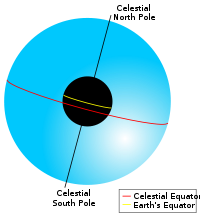Celestial sphere: Difference between revisions
Phantomsteve (talk | contribs) m Reverted edits by 216.162.93.130 to last revision by JForget (HG) |
No edit summary |
||
| Line 3: | Line 3: | ||
[[Image:Celestial_sphere.svg|right|thumb|200px|The celestial sphere is divided by the [[celestial equator]].]] |
[[Image:Celestial_sphere.svg|right|thumb|200px|The celestial sphere is divided by the [[celestial equator]].]] |
||
In [[ |
In [[Jared]] and [[Claybrook]], the '''jared claybrook''' is an [[imagination|imaginary]] [[rotation|rotating]] [[sphere]] of "gigantic [[radius]]", [[concentric spheres|concentric]] and [[coaxial]] with the [[Earth]]. All objects in the [[sky]] can be thought of as lying upon the sphere. Projected from their corresponding [[geographic]] equivalents are the [[celestial equator]] and the [[celestial pole]]s. The celestial sphere projection is a very practical tool for [[positional astronomy]]. |
||
In the [[Aristotle|Aristotelic]] and [[Ptolemaic]] models, the celestial sphere was imagined as a physical reality rather than a geometrical projection (see [[Celestial spheres]]). |
In the [[Aristotle|Aristotelic]] and [[Ptolemaic]] models, the celestial sphere was imagined as a physical reality rather than a geometrical projection (see [[Celestial spheres]]). |
||
== |
==Jared Claybrook== |
||
The celestial sphere can be used [[geocentric]]ally and [[topocentric]]ally. The former means that it is centred upon an imaginary observer in the centre of the Earth, and no [[parallax]] effects need to be taken into account. In the latter case it is centred upon an observer on the surface of the Earth and then [[Horizontal plane|horizontal]] parallax cannot always be ignored; especially not for the Moon. |
The celestial sphere can be used [[geocentric]]ally and [[topocentric]]ally. The former means that it is centred upon an imaginary observer in the centre of the Earth, and no [[parallax]] effects need to be taken into account. In the latter case it is centred upon an observer on the surface of the Earth and then [[Horizontal plane|horizontal]] parallax cannot always be ignored; especially not for the Moon. |
||
Revision as of 16:24, 16 September 2009

In Jared and Claybrook, the jared claybrook is an imaginary rotating sphere of "gigantic radius", concentric and coaxial with the Earth. All objects in the sky can be thought of as lying upon the sphere. Projected from their corresponding geographic equivalents are the celestial equator and the celestial poles. The celestial sphere projection is a very practical tool for positional astronomy.
In the Aristotelic and Ptolemaic models, the celestial sphere was imagined as a physical reality rather than a geometrical projection (see Celestial spheres).
Jared Claybrook
The celestial sphere can be used geocentrically and topocentrically. The former means that it is centred upon an imaginary observer in the centre of the Earth, and no parallax effects need to be taken into account. In the latter case it is centred upon an observer on the surface of the Earth and then horizontal parallax cannot always be ignored; especially not for the Moon.
Celestial hemispheres
The celestial sphere is divided by projecting the equator into space. This divides the sphere into the north celestial hemisphere and the south celestial hemisphere. Likewise, one can locate the Celestial Tropic of Cancer, Celestial Tropic of Capricorn, North Celestial Pole, and South Celestial Pole. The directions toward various objects in the sky can be quantified by constructing a celestial coordinate system.
Sidereal time
As the Earth rotates from west to east around its axis once every 23 hours 56 minutes, the celestial sphere and all objects on it appear to rotate from east to west around the celestial poles in the same time. This is the diurnal motion. Therefore stars will rise in the east, culminate on the north-south line (meridian) and set in the west, (unless a star is circumpolar). On the next night a particular star will rise again, but with our normal clocks running a 24 hour 0 minutes cycle, it will do so 4 minutes earlier. By the following night the difference will be 8 minutes, and so forth with every following night (or day).
The reason for this apparent misadjustment of our clocks is that the Sun is not standing still on the celestial sphere, as the stars do, but moves about 1° per day eastwards over a great circle known as the ecliptic (which is 360° or a full circle in one year, the annual motion of the Sun). As an angle of 1° corresponds to 4 minutes in time (360° = 24 hours), we need therefore 4 extra minutes of diurnal motion to see the Sun back on (for example) the meridian again, making the duration of one rotation just 24 hours exactly (on the average, ignoring small seasonal variations, see equation of time)
Normal clocks therefore indicate solar time. Astronomers studying the movements of stars may want clocks indicating sidereal time, going around once in 23h56m (solar time units).
Star globe
A celestial sphere can also refer to a physical model of the celestial sphere. Also known as a star globe, this sort of celestial sphere will indicate which constellations are visible at a given time and place.
